Today most people think of the iPhone as new product category for Apple. It wasn't. By 2006 the iPod was under pressure from Nokia's "Musicphones". Indeed Tomi Ahonen had already administered the last rights. The iPhone was the response. The iPod you could call upon.
It was first and foremost a defensive strategy. To upgrade the iPod users before they caught Nokia's media phone fever and were lost forever to new "Walled Garden".
If you have any doubts. Take another look at this ad broadcast during the product launch. The opening line? "There's never been an iPod that can do this". See Video.
In the end you could say Apple got lucky. While Apple introduced the App Store, Nokia platform burned brightly from within and the rest, as they say is history.
Today Apple's App Store is the 4th largest software "platform" on the planet. Apple wins. Developers win. Consumers win. Everybody wins. Except the competition.
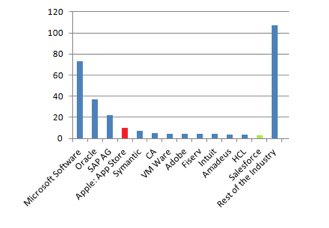
But that would be to miss the point.
In the four years after releasing the iPhone Apple spent 4x as much promoting the product as industry sources suggest they did building it.
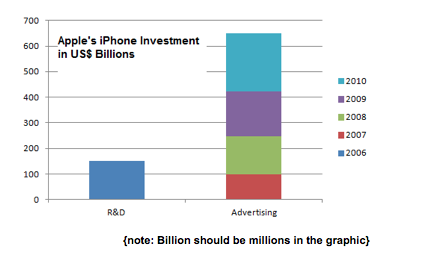
And with each ad they created another dimension to the social proof. A demonstration of just how this changes everything. See Video. And they didn't invest in social. They primarily invested in TV to ignite the imagination of the market and then let their fans do the talking.
It was old school marketing. By the book. And the extraordinary thing is, in the era of conversations and social media, it worked... brilliantly.
But the point I want to make here is the number: At least 4x the R&D was spent on getting the message out there. On making the promise: This changes everything. It's what you come to expect from Apple. We are in the business of changing everything we touch.
Each year they spent as much investing in the social proof as what they did when they made it.
What's more industry estimates suggest that not only did their Telco partners match this investment, they may well have quadrupled it. For example AT&T and Verizon spent an estimated $130+ Million alone.
Factor this into the disruptive equation and you discover the investment in manufacturing the social proof was over 20x the original R&D investment.
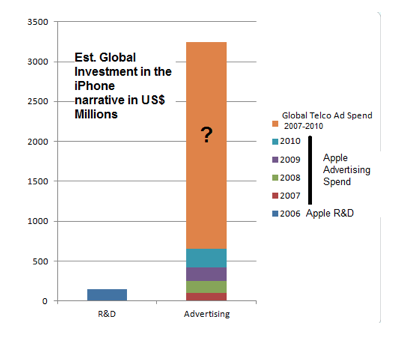
Add to this the untold level of investment in Free promotion via social media and app developers. And yet, if a global brand like Apple, with decades of history behind it, has to spend as much every year on promoting a game changing product like the iPhone, as they did building it - plus they need their retailers to pitch into to help enhance the viral narrative - what does that say about the level of investment in marketing and promotion required for an unknown start-up to break through?
Today an estimated 90% of the 1 million apps on offer in the App Store are free. Of the rest 6% are worth less than a dollar. And still the vast majority of these apps are not being downloaded. Why? Simply because the developers have left the market to decide what the product of their labour is worth. And strangely enough the market has chosen and accepted the price. The world is free, not because it is disrupted, but because we think this stuff sells itself. And yet the big data clearly illustrates it does not.
Truth is it never has.
s It always takes more money to make the market than it does to make the product. Just take a look at the history of Coca Cola. If you want to stay in the market you have to reinvent yourself each year. Each product cycle. Each time the customer comes knocking. It's the same old, same old. Always has been. Always will be.
But let's not stop there. Let's take a look at the impact this forgotten idea of "There's never been an iPod that can do this" has on the popular meme:Technology is adoption is speeding up.
We'll begin with the iPod/iPhone sales data.
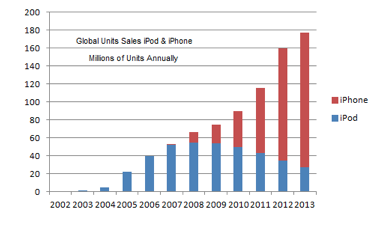
Do you see the continuation of the Rogers' adoption curve on the iPod? The product life cycle S curve as the new iPod phone displaces the old media player? The long cycle of upgrading customers, and continuing to expand the customer base vs. the grand disruption?
All pretty basic stuff. Simple ideas and realities of doing business in a connected world. Apparently lost in the hype of the disruptive "Jesus" phone narrative.
OK. Let's build on this observation to finally kill off any semblance of doubt you may have about the adoption of technology being faster today that at any other time in history.
This chart is a mess. It maps an abundance of technologies currently competing for oxygen in a crowded, and very mature market place - Electronic A/V Equipment.
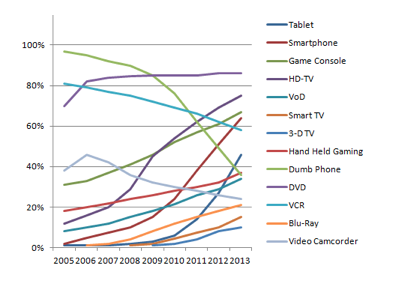
Seemingly it is the sheer abundance of technologies that makes the premise of the speeding up of technology adoption self evident. When in reality what is self evident is the fragmentation of the market as new technologies emerge to compete for the chance to displace the incumbents.
Here for example is the race to disrupt HD-TV. Which had previously disrupted analogue TV. Who will win Smart, 3-D or the new 4K entrant?
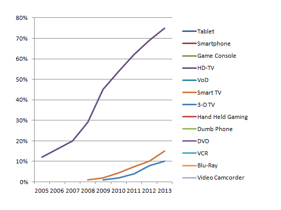
Same thing goes for DVD. Which previously disrupted VCR. Will it be Blu-ray of VoD or some other variant? I have included games consoles in the mix to demonstrate how convergence of technologies can impact on the adoption of emerging technologies like Blu-Ray and VoD.
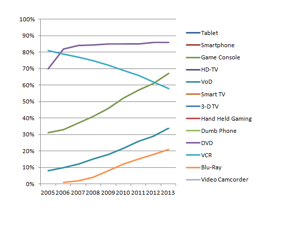
The key here though is to note the upgrade cycle. These technologies are displaced as they breakdown. Or, the content is no longer available in that format.
The point being the rate of adoption of this technology is a function of the product life cycle not the nature of the technology. To compare the invention of Blu-Ray with Electricity or even TV or Radio is fallacious.
Now let's take at the smartphone revolution.
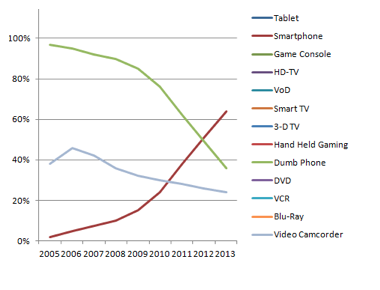
In this chart I have included the decline of the video camera to illustrate one of the established technologies that is being disrupted by the smartphone or what is better understood as the digital media phone.
Take a look at the growth in smartphone vs. the decline in the feature phone - or what is now described as the dumb phone - and you will see a mirror image. The question being why? The answer being the way mobile phones are purchased - or more accurately subsidised - as part of the network access contract. The speed of technology adoption is a function of the terms of trade rather than the disruptive nature of the technology. The latest phone is handed out to keep customers sticky. Its function, much the same as media, is that of a "Free" hook to sell more bandwidth.
So again, to compare the rise and rise of the smartphone over the past 7 years with the invention of Electricity, TV or Radio is fallacious. The smartphone needs to be understood for what it is. A popular product upgrade rather than a disruptive new technology.
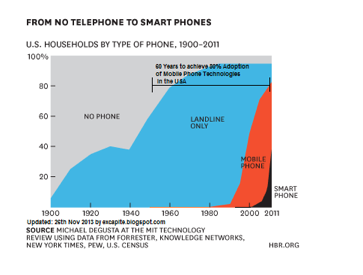
In the end understand this. Radio and TV were cultural revolutions that spark the imaginations of a generation.
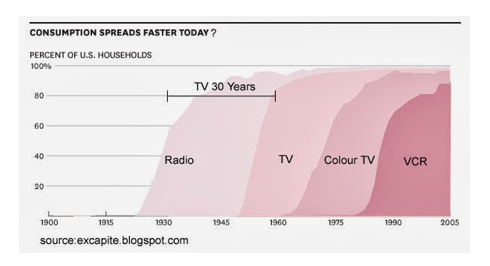
In contrast the revolutionary convergence of Mobile and the Web was a slow train coming. In many ways it still is... a work in progress I mean. Take the iPod phone out of the equation and arguably it still would be struggling to ignite the imagination. These technologies are part of a general slowing of the rate of change rather than the flagships of the acceleration towards the future.
They are simply another dimension of the mainstream American focus on optimising the past rather than a radical reinvention of the future.